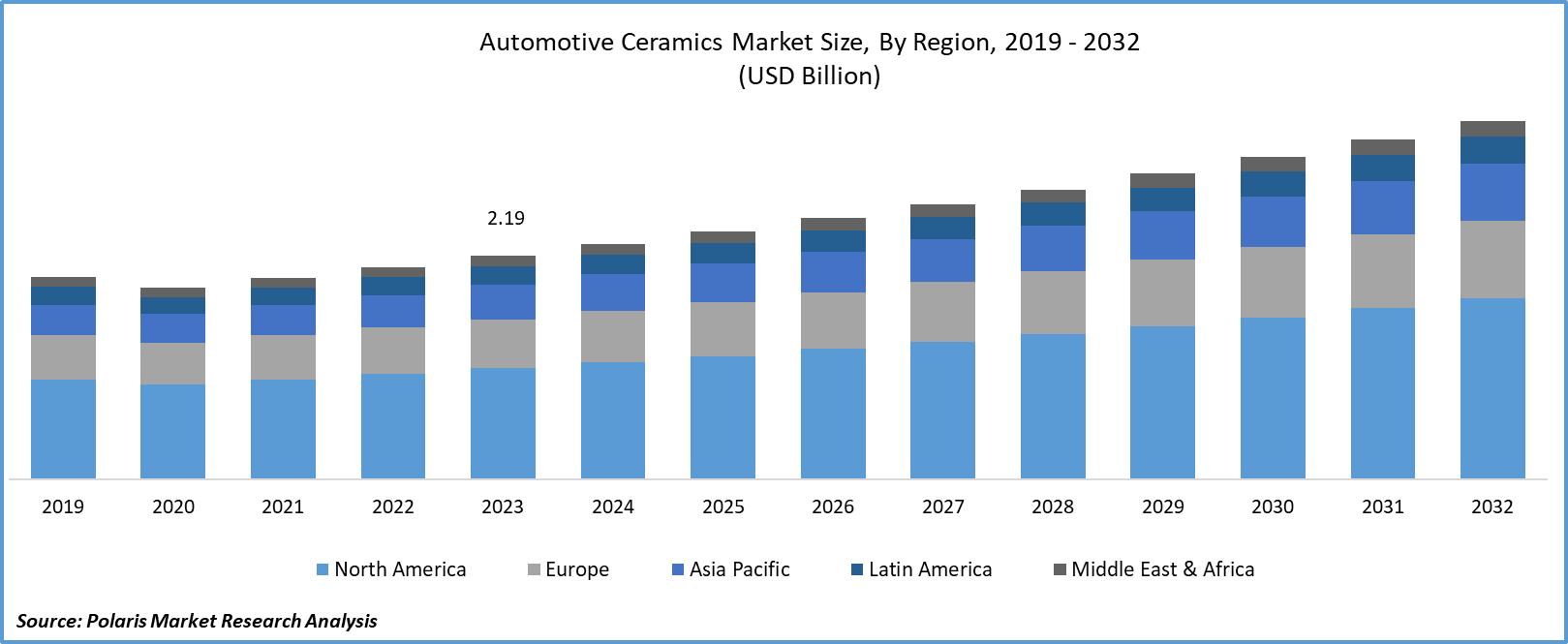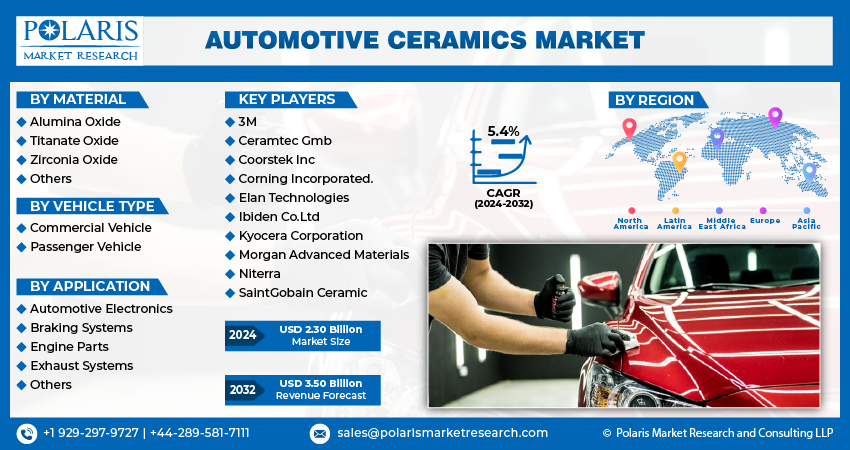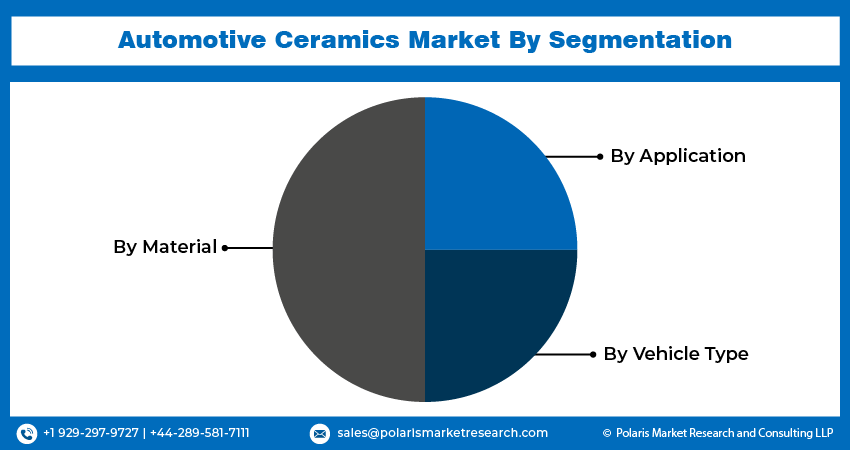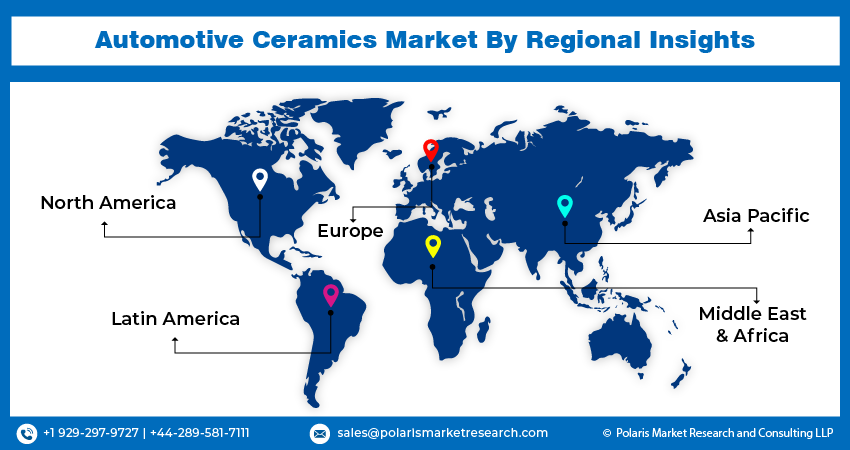
Automotive Ceramics Market Share, Size, Trends, Industry Analysis Report, By Material (Alumina Oxide, Titanate Oxide, Zirconia Oxide, And Others); By Vehicle Type; By Application; By Region.; Segment Forecast, 2024- 2032
- Published Date:Apr-2024
- Pages: 119
- Format: PDF
- Report ID: PM4867
- Base Year: 2023
- Historical Data: 2019-2022
Report Outlook
The automotive ceramics market size was valued at USD 2.19 billion in 2023. The market is anticipated to grow from USD 2.30 billion in 2024 to USD 3.50 billion by 2032, exhibiting a CAGR of 5.4% during the forecast period.
Industry Trend
Automotive ceramics represent advanced structural materials extensively utilized in manufacturing various spare parts for automobiles. Characterized by their hard, porous, and brittle nature, ceramics are favored for crafting lightweight components crucial for automotive applications. The primary advantages of these materials lie in their lightweight properties, contributing to reduced fuel consumption and enhanced efficiency and cost-effectiveness of automobiles. The burgeoning demand for electronics integration within vehicles is poised to drive the growth of automotive ceramics in the forthcoming years.
Automotive sensors, LED substrates, arc tubes, and spark plugs are among the components benefiting from advanced ceramic materials. Given the imperative role of electronic components and sensors in vehicle data management and system operation, the demand for ceramic-based solutions is anticipated to rise. Additionally, advancements in engine technologies, such as turbocharged engines and direct fuel injection systems, are facilitating more efficient engine design and operation, further propelling the demand for ceramic-based sensors. As a result, the automotive ceramics market share is expected to show the fastest growth in the forecast period.

To Understand More About this Research: Request a Free Sample Report
Moreover, the growth of the automotive ceramics market is fueled by increased global vehicle production in response to heightened demand for passenger and commercial vehicles. As automotive manufacturers strive to meet consumer demands, there is a corresponding surge in the demand for ceramic components, amplifying the market's growth.
The automotive ceramics sector is witnessing a landscape of increasing investment aimed at expanding product portfolios. This trend is fueled by growing demand for lightweight, durable components in vehicles. Investments target innovations in materials and manufacturing processes, driving the development of advanced ceramic solutions for various automotive applications.
The development of low-cost manufacturing technologies for ceramic-based components is expected to provide lucrative opportunities for the growth of the automotive ceramics market, resulting in significant growth during the forecast period.
Key Takeaway
- Asia Pacific dominated the largest market and contributed to more than 38% of the share in 2023.
- The North America market is expected to witness the fastest-growing CAGR during the forecast period.
- By material category, the zirconia oxide segment accounted for the largest market share in 2023.
- By vehicle type category, the passenger vehicle segment is projected to grow at a high CAGR during the projected period.
What are the Market Drivers Driving the Demand for the Automotive Ceramics Market?
Increasing Global Vehicle Production Growth have been Projected to Spur Product Demand
The burgeoning automotive industry, propelled by a rising global demand for both passenger and commercial vehicles, plays a pivotal role in driving the increasing demand for automotive ceramics. As automotive manufacturers strive to meet the escalating consumer demands, vehicle production undergoes significant expansion. This surge in production necessitates the integration of lightweight yet durable components, and automotive ceramics emerge as a key solution to this requirement.
With the automotive sector scaling up production volumes to keep pace with consumer preferences and market dynamics, the demand for ceramic components experiences a corresponding upswing. Manufacturers seek ceramic materials due to their unique properties, including lightweight nature, durability, and resistance to high temperatures and corrosion. These characteristics make ceramics indispensable for various critical applications within vehicles, ranging from engine components to electronic systems. As a result, the automotive ceramics market share is expected to show the fastest growth during the forecast period.
Moreover, as vehicle production scales up, automotive manufacturers are increasingly focusing on enhancing vehicle performance, fuel efficiency, and sustainability. Ceramic components contribute significantly to these objectives by enabling lighter vehicle designs, optimizing engine efficiency, and improving overall vehicle performance. This growing emphasis on performance and efficiency further accentuates the demand for automotive ceramics in the global automotive industry. As a result, the automotive ceramics market share is expected to show the fastest growth during the forecast period.

Which Factor is Restraining the Demand for the Automotive Ceramics Market?
The Presence of Alternative Materials is Expected to Hinder the Growth of the Market
While ceramics offer many benefits, such as lightweight properties, durability, and resistance to high temperatures, there may be instances where other materials or technologies offer comparable performance at a lower cost or with easier integration.
The advancements in alternative lightweight materials or composite materials may provide viable substitutes for certain applications traditionally dominated by ceramics. Additionally, developments in additive manufacturing or 3D printing technologies may offer new possibilities for producing complex components at lower costs, potentially reducing the reliance on traditional ceramic manufacturing processes.
Moreover, if automotive manufacturers face economic challenges or shifts in consumer preferences that prioritize cost savings over performance enhancements, they may opt for more cost-effective materials, thereby impacting the demand for automotive ceramics and hindering the growth automotive ceramics market.
Report Segmentation
The market is primarily segmented based on material, vehicle type, application, and region.
|
By Material |
By Vehicle Type |
By Application |
By Region |
|
|
|
|
To Understand the Scope of this Report: Speak to Analyst
Category Wise Insights
By Material Insights
Based on the material analysis, the market is segmented into alumina oxide, titanate oxide, zirconia oxide, and others. The Zirconia oxide held the largest market share in 2023. Zirconia oxide possesses exceptional mechanical properties, including high strength, toughness, and wear resistance. These characteristics make it well-suited for demanding automotive applications such as engine components, bearings, and sensors. It exhibits excellent thermal stability, enabling it to withstand high temperatures without deformation or degradation. This property is crucial for components operating in extreme conditions within automotive engines and exhaust systems. Zirconia oxide is highly resistant to corrosion from various chemicals and automotive fluids, ensuring the longevity and reliability of ceramic components in harsh automotive environments. Zirconia oxide has excellent electrical properties, making it suitable for applications such as oxygen sensors and electronic components within vehicles.
By Vehicle Type Insights
Based on vehicle type analysis, the market has been segmented on the basis of commercial vehicles and passenger vehicles. The passenger vehicle segment is expected to witness the fastest-growing CAGR during the forecast period. Increasing disposable incomes, urbanization, and changing lifestyles have led to a surge in demand for passenger vehicles worldwide. As more consumers aspire to own personal vehicles for commuting and leisure purposes, the production and sales of passenger vehicles are expected to grow significantly. Passenger vehicles are increasingly incorporating advanced technologies to enhance performance, safety, and comfort. Automotive ceramics play a crucial role in enabling these advancements, such as in engine components, sensors, catalytic converters, and electronic systems. As vehicle manufacturers continue to innovate and introduce new features in passenger vehicles, the demand for ceramic components is expected to rise correspondingly.

Regional Insights
Asia Pacific
Asia Pacific region accounted for the largest market share in 2023. Rising incomes, urbanization, and improving living standards have increased vehicle ownership in the Asia Pacific region. As more consumers purchase cars for personal and commercial use, the demand for automotive ceramics as essential components in vehicle manufacturing has surged. The Asia Pacific region is at the forefront of technological innovation and has seen a rapid expansion in the integration of electronic components in vehicles. Automotive ceramics play a crucial role in electronic systems such as sensors, LED substrates, and circuit boards, driving their demand in the region. Hence, the Asia Pacific market to dominate in automotive ceramics market in the forecast period. Top of FormNorth
North America
North America is expected to witness the fastest CAGR during the forecast period. The adoption of electric vehicles (EVs) is rapidly increasing in North America, driven by factors such as government incentives, environmental awareness, and advancements in EV technology. Automotive ceramics play a crucial role in EV batteries, electric motors, and power electronics, making them essential components for electric vehicle manufacturers. As the EV market expands in North America, the demand for ceramic materials is expected to rise accordingly. Ceramic materials offer significant weight savings compared to traditional metals, making them attractive for applications where weight reduction is critical; as a result, the automotive ceramics market share is expected to show the fastest growth in the forecast period. As automakers prioritize lightweighting strategies, the demand for ceramic components is expected to increase in North America. Consumers in North America have shown a growing preference for vehicles equipped with advanced technologies and features. Automotive ceramics enable the integration of advanced electronic systems, sensors, and other high-performance components in vehicles, meeting consumer demand for innovative and technologically advanced vehicles.

Competitive Landscape
The automotive ceramics market exhibits fragmentation, hosting a multitude of competitors. Key players within this domain continually enhance their technological prowess to maintain a competitive edge, prioritizing efficiency, reliability, and safety. Establishing a formidable market presence; these entities underscore the significance of strategic alliances, ongoing product enhancements, and collaborative ventures as crucial strategies to outshine industry counterparts.
Some of the major players operating in the global market include:
- 3M
- Ceramtec Gmb
- Coorstek Inc
- Corning Incorporated.
- Elan Technologies
- Ibiden Co.Ltd
- Kyocera Corporation
- Morgan Advanced Materials
- Niterra
- SaintGobain Ceramic
Recent Developments
- In March 2023, Ceramtec GmbH unveiled its latest offering, Rubalit ZTA, a high-performance ceramic substrate renowned for its exceptional flexural strength, efficient thermal conductivity, remarkable electrical insulation, and superior dielectric strength.
Report Coverage
The automotive ceramics market report emphasizes on key regions across the globe to provide better understanding of the product to the users. Also, the report provides market insights into recent developments, trends and analyzes the technologies that are gaining traction around the globe. Furthermore, the report covers in-depth qualitative analysis pertaining to various paradigm shifts associated with the transformation of these solutions.
The report provides detailed analysis of the market while focusing on various key aspects such as competitive analysis, material, vehicle type, application, and their futuristic growth opportunities.
Automotive Ceramics Market Report Scope
|
Report Attributes |
Details |
|
Market size value in 2024 |
USD 2.30 billion |
|
Revenue forecast in 2032 |
USD 3.50 billion |
|
CAGR |
5.4% from 2024 – 2032 |
|
Base year |
2023 |
|
Historical data |
2019 – 2022 |
|
Forecast period |
2024 – 2032 |
|
Quantitative units |
Revenue in USD billion and CAGR from 2024 to 2032 |
|
Segments covered |
By Material, By Vehicle Type, By Application And By Region |
|
Regional scope |
North America, Europe, Asia Pacific, Latin America, Middle East & Africa |
|
Customization |
Report customization as per your requirements with respect to countries, region, and segmentation. |
FAQ's
The Automotive Ceramics Market report covering key segments are material, vehicle type, application, and region.
Automotive Ceramics Market Size Worth $3.50 Billion by 2032
The automotive ceramics market exhibiting a CAGR of 5.4% % during the forecast period
Asia Pacific is leading the global market
key driving factors in Automotive Ceramics Market are increasing global vehicle production growth
